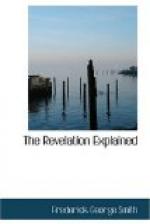Under each of these first three trumpets the extent of destruction is indicated by the expression “the third part.” Since the successive steps in the downfall of the empire is the subject under consideration, this expression as here applied doubtless has particular reference to the loss of political power and life, rather than referring directly to the loss of human life sustained. With this thought in view, it is evident that the political importance of the empire was entirely destroyed by these desolating incursions. Of the truth of this fact all historians agree. Nothing of Rome remained, except the semblance of a government, when the time arrived for the sounding of the next trumpet.
12. And the fourth angel sounded, and the third part of the sun was smitten, and the third part of the moon, and the third part of the stars; so as the third part of them was darkened, and the day shone not for a third part of it, and the night likewise.
The symbol of this trumpet is that of an eclipse of sun, moon, and stars, so that they shone not for a third part of the day and night. Under the sixth seal we showed that these luminaries of heaven are taken as symbols of rulers and princes; for the latter bear an analagous relation to the empire that the former do to the earth. In the darkening, then, of the sun, moon, and stars, we are to look for some disastrous change or overthrow in the imperial government. Such an event occurred only a few years after the events described under the preceding trumpets. With her political strength and resources exhausted, Rome could no longer maintain a separate existence, and Odoacer, king of the Heruli, overthrew Momyllus Augustulus, the last of the Roman line of emperors, and caused himself to be proclaimed king of Italy in A.D. 476. This terminated the Western empire; and thus was the Roman sun eclipsed in darkness. In a subsequent chapter, however, we will find the eclipse lifted at a later period and New Rome enjoying all the power and authority lost in her predecessors of the old Augustin line.
Odoacer continued in possession of his kingdom seventeen years. Then he was defeated and slain by Theodoric, and by him the kingdom of the Ostrogoths was established in Italy. Sixty years later this kingdom was subverted by Belisarius, the general of Justinian, emperor of the East, to whom it became a tributary province. In each of the principal cities of Italy Justinian appointed a governor with the title of Duke, in subordination to another with the title of Exarch, whose residence was at Ravenna. “Thus, at last, was Rome, once the proud mistress of the world, reduced to a poor dukedom, made tributary to the Exarch of Ravenna, and he holding his authority at the will of the emperor of Constantinople, the seat of the Eastern empire.”




